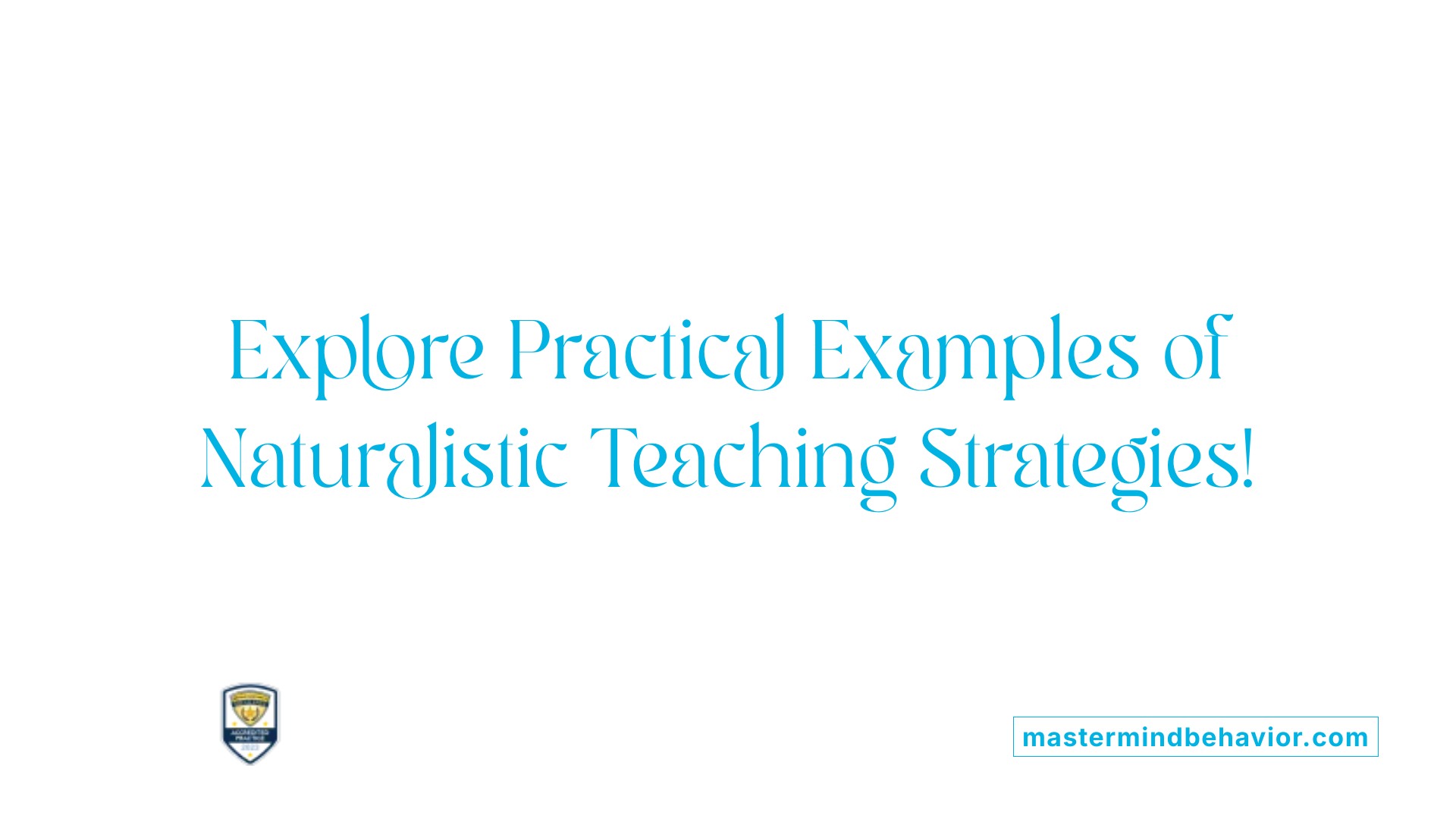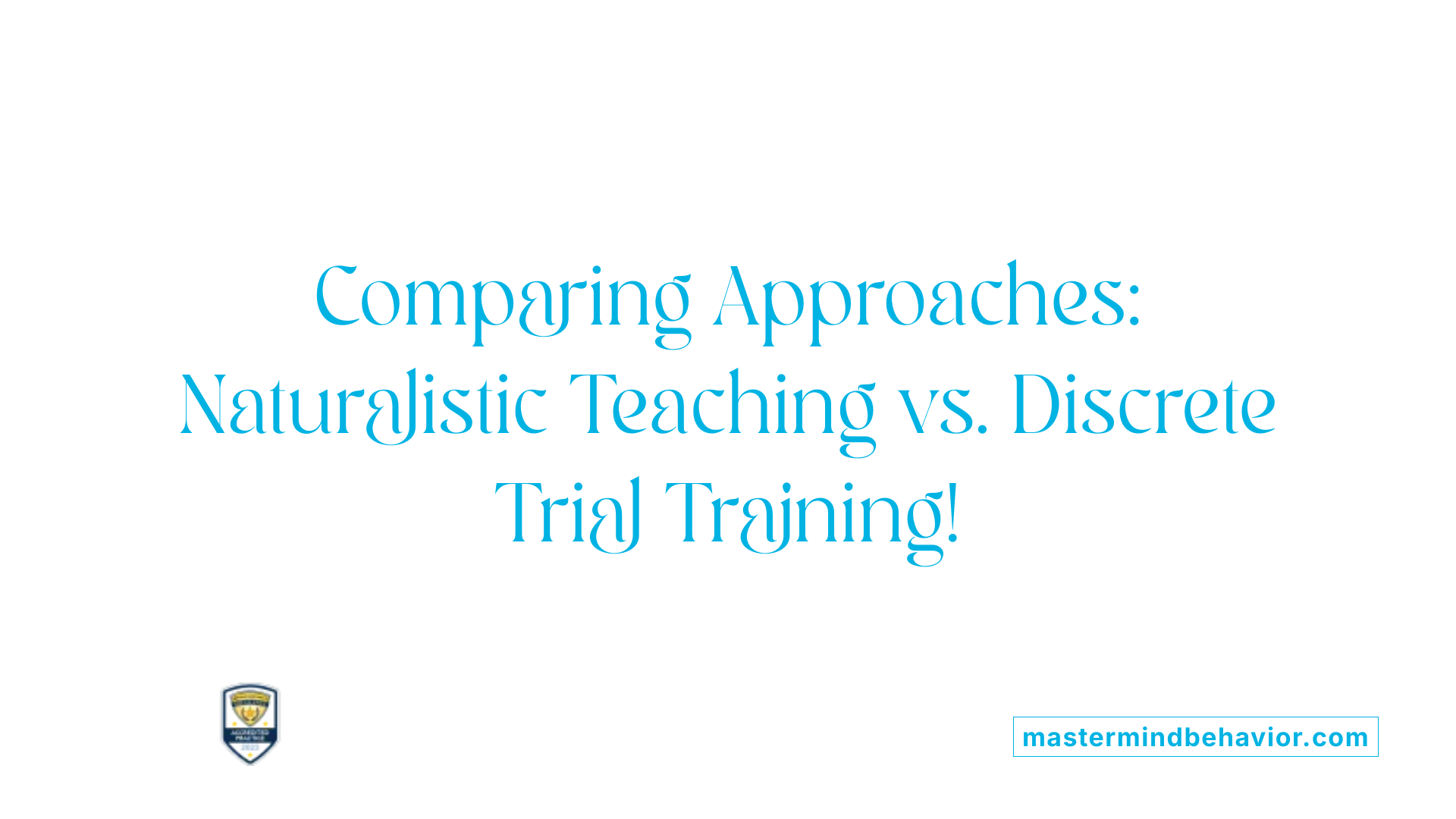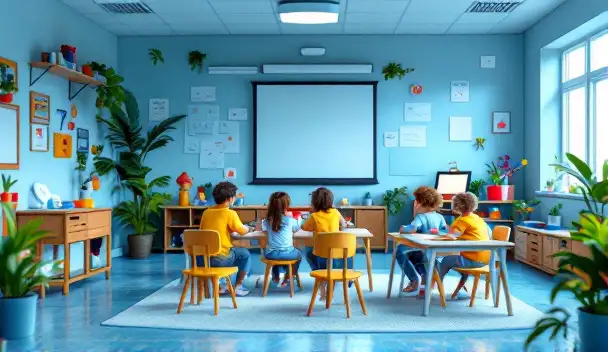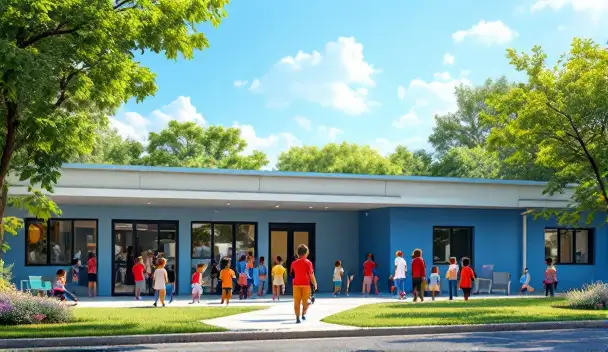How to Implement Naturalistic Teaching in ABA Therapy

Understanding Naturalistic Teaching in ABA Therapy
Naturalistic teaching is an evidence-based approach within Applied Behavior Analysis (ABA) therapy, particularly effective for children with Autism Spectrum Disorder (ASD). It integrates learning directly into a child's natural environment and daily routines, emphasizing learning through play and meaningful interactions. Unlike traditional, structured ABA methods, such as Discrete Trial Training (DTT), naturalistic teaching is adaptable and child-focused, tailoring therapeutic practices to the individual's interests and real-life contexts. This article explores how to implement naturalistic teaching, its benefits, strategies, and a comparison with other ABA approaches.
The Benefits of Naturalistic Teaching in ABA Therapy

What is naturalistic teaching in ABA therapy and what are its benefits?
Naturalistic teaching in ABA therapy emphasizes learning within the child's own environment, utilizing strategies that are engaging and relevant to their daily life. Unlike more traditional methods such as Discrete Trial Training (DTT), this approach is flexible and prioritizes play-based interactions aligned with a child's personal interests.
Key strategies incorporate techniques like Pivotal Response Training (PRT), which addresses broader behavioral motivations, Incidental Teaching (IT), where spontaneous events are utilized for teaching opportunities, and the Natural Language Teaching Paradigm (NLT), aimed at enhancing communication through play.
The benefits of naturalistic teaching are significant.
- Skill Generalization: Children learn in real-life contexts, making it easier to apply their skills across different settings.
- Increased Motivation: By allowing children to engage in learning through activities they enjoy, motivation levels are significantly heightened.
- Enhanced Communication and Social Skills: This method promotes spontaneous interactions, particularly important for children with autism who may struggle with communication in structured settings.
- Family Involvement: The family-friendly nature of this approach encourages parental participation, making it easier to integrate learning into everyday routines.
- Enjoyable Learning Experience: Naturalistic teaching is designed to be enjoyable, making the learning process less aversive for children, thus fostering a love for learning.
Research supports these methods, showing improvements in language acquisition and adaptive skills, demonstrating that naturalistic methods can create meaningful, lasting changes in a child's development.
Implementing Effective Naturalistic Teaching in Therapeutic Settings

How can naturalistic teaching be implemented effectively in ABA therapy?
Naturalistic teaching thrives in settings that incorporate a child's interests and everyday activities. By embedding learning opportunities into familiar routines, children can acquire skills in ways that feel natural and engaging. For example, during mealtimes, a caregiver can prompt a child to request food items, effectively practicing communication in a context that holds meaning for them.
Techniques for integrating learning in natural environments
Several techniques enhance the effectiveness of naturalistic teaching in real-world settings:
- Incidental Teaching: This method taps into spontaneous moments during play for learning opportunities. For instance, if a child shows interest in a toy, the adult can prompt a request, allowing the child to practice language skills.
- Mand-Model Approach: Adults model requests and wait for the child to respond, supporting independent communication.
- Milieu Teaching: Engaging the child in their environment with strategically placed toys can motivate them to ask for what they desire, facilitating interaction.
Child-led learning methods
The child-led aspect of naturalistic teaching encourages exploration and choice. Children are more likely to engage and learn when they have control over their activities. This approach can include:
- Allowing children to choose games or toys they enjoy.
- Following the child’s lead during play, which promotes natural conversations.
Role of caregivers
Caregivers play a vital role in naturalistic teaching. Their involvement ensures that therapy is consistent and relevant to the child’s daily life. Training caregivers to observe and reinforce learning moments can lead to effective interventions tailored to the child's unique needs. By using positive reinforcement, caregivers can boost motivation and enhance engagement, making learning both enjoyable and impactful.
In conclusion, implementing naturalistic teaching within ABA therapy requires a shift towards child-centered learning in natural settings, making educational experiences relevant, engaging, and applicable to the real world.
Examples of Naturalistic Teaching Strategies

What are some examples of naturalistic teaching strategies in ABA therapy?
Naturalistic teaching strategies are integral to providing effective support in ABA therapy, particularly for children with Autism Spectrum Disorder (ASD). These strategies leverage the child’s environment and interests to encourage meaningful skill development.
1. Incidental Teaching
Incidental teaching focuses on creating spontaneous learning opportunities within natural interactions. For example, if a child is playing with a toy car, a therapist might wait for the child to express a desire for a different toy, thereby prompting communication. This method enhances vocabulary, improves social interactions, and makes learning feel more relevant and enjoyable.
2. Pivotal Response Training (PRT)
PRT zeroes in on pivotal behaviors that can lead to significant overall development. For instance, it encourages self-initiated communication and motivation by allowing the child to choose their activities during playtime. This child-led approach not only engages children but fosters skills that are transferable across various settings, such as initiating conversations with peers.
3. Natural Language Paradigm (NLP)
The natural language paradigm integrates language learning within play, enhancing opportunities for spontaneous communication. During mealtime, for instance, a child might be encouraged to ask for an out-of-reach food item. By embedding language opportunities in everyday situations, NLP helps children improve their communication skills within meaningful contexts.
These naturalistic strategies not only make learning fun but also promote the generalization of skills in the child’s daily life, improving language, social, and play skills, as supported by research.
Comparing Naturalistic Teaching and Discrete Trial Training in ABA

How does naturalistic teaching compare to Discrete Trial Training in ABA therapy?
Naturalistic teaching, often recognized as Natural Environment Teaching (NET), stands in contrast to Discrete Trial Training (DTT) by placing an emphasis on learning through everyday activities. This method leverages a child's natural interests and incorporates play-based strategies, allowing skills to be taught in real-life settings. For instance, a child might learn to request a drink after a walk, merging their environment with the learning objective in a less structured, more engaging way.
Conversely, DTT involves a more regimented approach, breaking skills into smaller, sequential steps and teaching them in controlled environments, typically on a one-to-one basis. This structure makes it easier to measure specific skills but can become less relevant for generalization in natural contexts. In contrast, NET fosters spontaneity, promoting skills like communication and social interaction through authentic interactions rather than rote memorization.
| Aspect | Naturalistic Teaching (NET) | Discrete Trial Training (DTT) |
|---|---|---|
| Learning Method | Play-based, integrated into daily life | Structured, specific skill breakdown |
| Skill Generalization | High; based on real-life context | Moderate; often limited to structured settings |
| Engagement | Child-led and interest-driven | Clinician-led and often less engaging |
Research has indicated that naturalistic methods may lead to improved generalization of skills (Andrade et al., 2019). Both approaches can be beneficial in ABA therapy, with many practitioners advocating for a blended strategy. While DTT offers a clear framework and systematic data collection essential for some learners, NET provides dynamic opportunities for skill application in everyday settings, enhancing the child's learning experience.
Conducting Naturalistic Teaching Sessions
Integration into Daily Routines
Naturalistic teaching sessions thrive on embedding learning into children's daily routines. Instead of formal, scheduled interventions, these sessions occur spontaneously within the context of everyday activities. For example, when a child returns from a walk, a therapist might encourage them to request water, seamlessly integrating a teaching moment into a routine task. This method helps children learn skills that are directly applicable to real-life situations, increasing the likelihood they will use these skills outside of therapy.
Focus on Communication
Communication skills are central to naturalistic teaching sessions. Techniques such as incidental teaching create opportunities for children to engage in conversation, prompting them to express their thoughts, desires, or needs in a natural way. For instance, a therapist might use gestures or position a desired toy out of reach, motivating the child to ask for it. This spontaneous interaction is crucial in helping children generalize their communication skills across different contexts and with various partners, fostering a more fluid and adaptable ability to communicate.
Environment Setup
The physical environment plays a vital role in naturalistic teaching. It should be rich in learning opportunities with engaging materials that pique the child’s interests. For instance, creating a play area that incorporates toys the child loves can stimulate spontaneous interactions and learning. Additionally, organizing the environment to encourage exploration and movement can further enhance the learning experience by promoting active engagement. By tailoring the environment to meet the child's needs, parents and therapists can significantly boost the efficacy of naturalistic teaching sessions.
Involving Families in Naturalistic Teaching
Family Participation
Naturalistic teaching fosters an inclusive environment where families can actively participate in their child's learning. This approach is designed to be family-friendly, allowing parents and caregivers to engage directly with techniques that enhance their child’s skills.
Training Caregivers
Effective naturalistic teaching requires thorough training for caregivers. Providing them with the necessary skills to recognize and utilize everyday teaching moments can substantially increase learning opportunities. Training ensures that family members can confidently integrate naturalistic strategies into daily routines, thus supporting their child's development in real-world contexts.
Real-life Applications
Incorporating therapy into daily life can make learning relevant and enjoyable. For example, parents can use mealtime to encourage requesting behaviors or label items during play. These everyday interactions promote skill generalization and allow children to apply what they have learned in therapy in various settings, facilitating smoother transitions into independent skill usage.
Challenges and Solutions in Naturalistic Teaching
Overcoming Barriers in Naturalistic Teaching
Implementing Naturalistic Teaching can pose challenges, particularly due to interruptions and distractions in a child's natural environment. To overcome these barriers, it is essential to create a structured yet flexible routine that allows for spontaneous learning opportunities.
Strategies for Consistency
Consistency across different environments is crucial for the effectiveness of Naturalistic Teaching. Training for parents and caregivers can ensure that they understand how to apply techniques in day-to-day interactions. Collaborative efforts between therapists and families can reinforce consistent practices that maximize learning opportunities.
Addressing Distractions
Minimizing distractions in the learning environment can enhance focus during sessions. This might involve arranging the space to reduce background noise or visual clutter. Setting up play areas with relevant toys can capture a child's attention, thus promoting engagement and reinforcing learning outcomes.
Research and Evidence Supporting Naturalistic Teaching

Effectiveness studies
Naturalistic Teaching has been supported by various studies that underscore its effectiveness in promoting learning in children with Autism Spectrum Disorder (ASD). Research indicates that techniques such as Incidental Teaching and Pivotal Response Training result in significant improvements in areas like language acquisition and social skills. Compared to more structured methods like Discrete Trial Training, studies have shown that children engaging in naturalistic methods demonstrate better generalization of skills to everyday settings.
Outcomes for children with ASD
When implemented correctly, Naturalistic Teaching yields positive outcomes for children with ASD, including enhanced communication and social interaction. It allows children to learn skills through contexts they naturally encounter, making it easier for them to apply what they've learned in diverse situations. Many children show notable progress in both verbal and non-verbal communication, indicating its utility in supporting various learners.
Adaptability across environments
One of the standout features of Naturalistic Teaching is its adaptability. The methods can be seamlessly integrated into multiple environments, such as home, school, and community settings. This flexibility enables parents and caregivers to reinforce learning opportunities throughout daily routines, thereby enhancing the overall effectiveness of the strategies employed.
The Future of Naturalistic Teaching in ABA
As ABA therapy continues to evolve, naturalistic teaching represents a promising approach for promoting adaptive skills in children with autism. Its emphasis on contextually relevant learning and engagement offers benefits not only for the children but also for families, as parents and caregivers play pivotal roles in implementing these strategies. By focusing on child-led interactions and real-life applicability, naturalistic teaching enhances the generalization of skills, fosters independence, and contributes to meaningful developmental progress. By integrating naturalistic teaching methods into standard ABA practices, therapists and educators can create more inclusive and responsive learning environments that cater to the diverse needs of each child.
References
- How is Naturalistic Teaching Used in ABA? - Bierman Autism Centers
- How is Naturalistic Teaching Used in ABA? Autism Treatment!
- Naturalistic teaching in ABA | Autism Resources - Songbird Therapy
- How naturalistic teaching is used in ABA therapy
- BCBA Explains Naturalistic Teaching in ABA Therapy
- What is Naturalistic Teaching ABA?
- Naturalistic Teaching Strategies in ABA Therapy
- What is Naturalistic Teaching in ABA? Techniques & Benefits
- The Art of Naturalistic Teaching - Bluesprig Autism
Recent articles

ABA Therapy To Support Academic Confidence In Young Learners
Building Foundations for Success: How ABA Therapy Enhances Academic Confidence in Young Learners

How ABA Therapy Supports Adolescents In Group Discussions
Enhancing Social Skills Through Evidence-Based Interventions

Importance Of Regular Goal Reviews And Modifications In ABA Therapy
Maximizing Progress Through Continuous Goal Optimization in ABA

What Role Parent Observations Play In Shaping ABA Adjustments
Enhancing ABA Interventions Through Parental Insights

How ABA Therapy Helps With Following Directions In Community Settings
Enhancing Independence Through Structured Guidance

ABA Therapy Strategies For Teaching Social Responsibility
Fostering Social Responsibility: Innovative ABA Approaches



